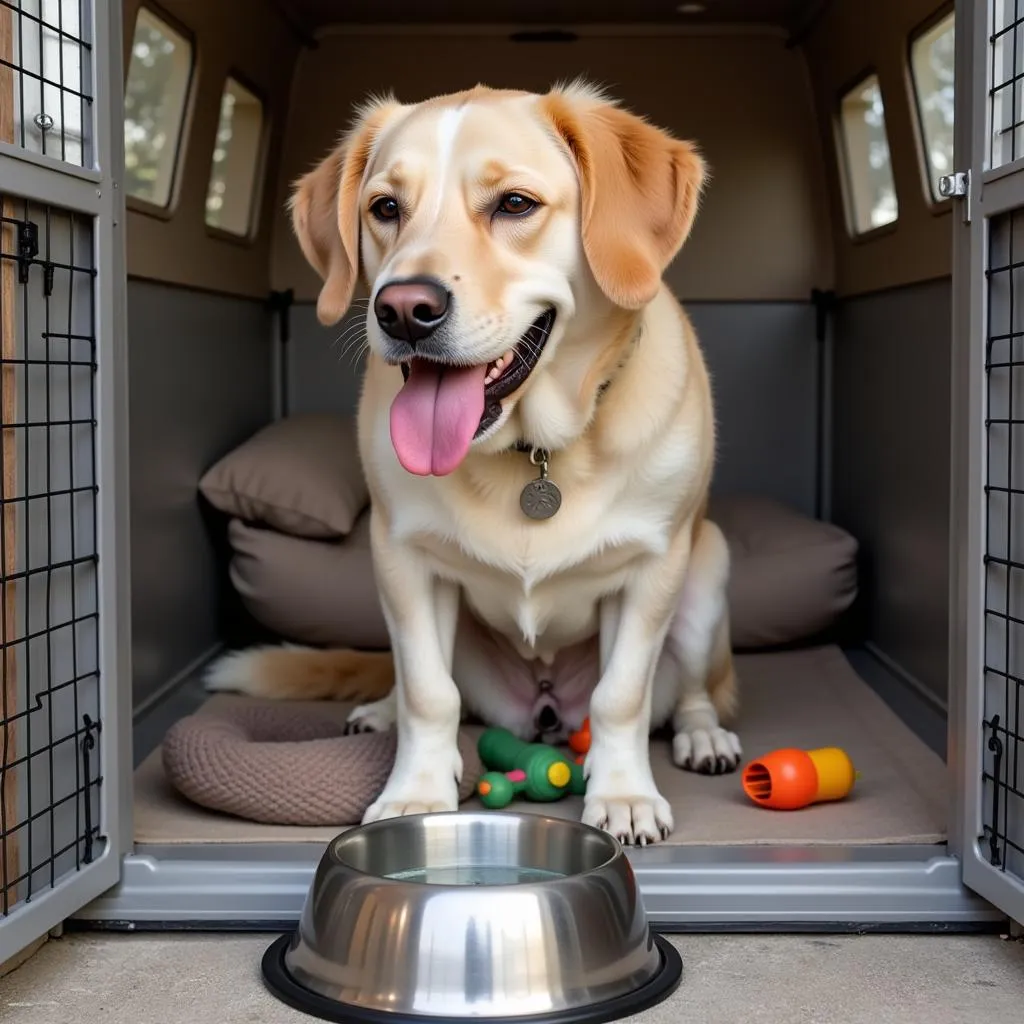When it comes to crate training, one of the most common questions new dog owners have is, “Do you put food and water in a dog crate?” The answer isn’t always a simple yes or no. While it’s generally considered safe to leave water accessible to your pup in their crate, the decision to include food requires a bit more consideration. Let’s delve into the factors you should consider when deciding the best approach for your furry companion.
Water in the Crate: A Must-Have
 Dog Drinking Water from Bowl in Crate
Dog Drinking Water from Bowl in Crate
Just like us, dogs need constant access to fresh water, and this holds true even when they’re spending time in their crates. Dehydration can be a serious health risk, especially for puppies. Providing a constant supply of water ensures your furry friend stays hydrated and comfortable throughout the day, whether you’re at home or away for a few hours.
Tips for Providing Water in the Crate:
- Choose the right bowl: Opt for a tip-proof, stainless steel or ceramic bowl that attaches securely to the crate to prevent spills and messes.
- Consider a crate water bottle: These bottles dispense water as your dog licks the spout, minimizing the risk of spills and keeping the water fresher for longer.
- Regular refills: Be sure to refresh the water bowl or bottle frequently, especially during warmer months or after exercise.
Food in the Crate: It Depends
Unlike water, providing food in the crate requires a more nuanced approach. While some dogs thrive on having their meals in their safe space, others might not benefit from it. Here’s a breakdown of the pros and cons:
Benefits of Feeding in the Crate:
- Positive Association: Feeding your dog in their crate helps create a positive association with the space. It becomes a place where they receive enjoyable things, making them more likely to enter willingly and feel relaxed inside.
- Easier Cleanup: If your dog is prone to making a mess during mealtime, feeding them in the crate can help contain any spills and crumbs, making cleanup a breeze.
- Training Aid: For puppies or dogs new to crate training, feeding them their meals in the crate can be a helpful training tool. It encourages them to enter the crate voluntarily and helps them associate it with positive experiences.
Potential Drawbacks of Feeding in the Crate:
- Weight Management: If your dog tends to overeat or isn’t food motivated, having constant access to food in the crate can lead to weight gain.
- Digestive Issues: Some dogs may benefit from having a designated eating area outside of their crate, especially if they’re prone to digestive issues like bloating.
- Food Guarding: If your dog exhibits any signs of food guarding, such as growling or snapping when approached while eating, it’s best to feed them outside the crate to avoid reinforcing this behavior.
 Happy Dog Eating from Bowl Outside Crate
Happy Dog Eating from Bowl Outside Crate
Factors to Consider
The decision of whether or not to put food in your dog’s crate ultimately depends on your individual dog and their specific needs. Here are some factors to consider:
- Age: Puppies generally benefit from having their meals in the crate as part of the crate training process.
- Eating Habits: If your dog is a messy eater or tends to overeat, it might be best to feed them outside the crate.
- Health Conditions: If your dog has any health conditions like diabetes or food allergies, consult with your veterinarian for personalized guidance on feeding in the crate.
- Crate Training Progress: Once your dog is comfortable and relaxed in their crate, you can gradually experiment with feeding them inside to see what works best for them.
“Every dog is unique,” says Dr. Emily Parker, a certified veterinary behaviorist. “Paying attention to your dog’s individual needs and preferences is crucial when deciding on crate feeding. There’s no one-size-fits-all approach.”
Conclusion
Providing access to fresh water in your dog’s crate is essential, but the decision to include food requires careful consideration of your dog’s individual needs and habits. By observing their behavior, consulting with your veterinarian, and gradually experimenting with different approaches, you can create a safe, comfortable, and enriching crate environment that promotes their well-being. If you need further guidance on crate training or have any concerns about your dog’s health and nutrition, don’t hesitate to contact us. Our dedicated team at Mina Cones Food is always here to help!
FAQs
- Can I leave a puppy alone with water in its crate? Yes, it’s crucial to leave fresh water accessible to puppies in their crates at all times. However, puppies have smaller bladders and may need more frequent potty breaks.
- What type of water bowl is best for a crate? Stainless steel or ceramic bowls that attach securely to the crate are ideal as they are durable, easy to clean, and prevent spills.
- Should I take my dog’s food away at night? Once your dog is housebroken and no longer needs nighttime potty breaks, it’s generally safe to leave food out overnight. However, it’s best to consult with your vet for personalized advice.
- Can I use a regular bowl for food in the crate? While you can use a regular bowl, it’s best to opt for one that is heavy and tip-proof to minimize messes.
- My dog is overweight. Should I feed them in the crate? It’s best to consult with your vet if your dog is overweight. They can recommend appropriate feeding strategies and determine if crate feeding is suitable.
Need more help? Contact our team at Mina Cones Food!
Phone: 02437655121
Email: minacones@gmail.com
Address: 3PGH+8R9, ĐT70A, thôn Trung, Bắc Từ Liêm, Hà Nội, Việt Nam.
We are available 24/7 to assist you!